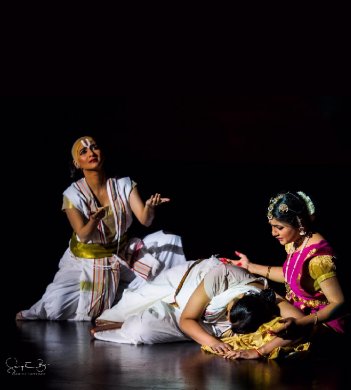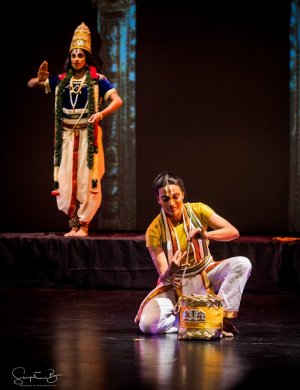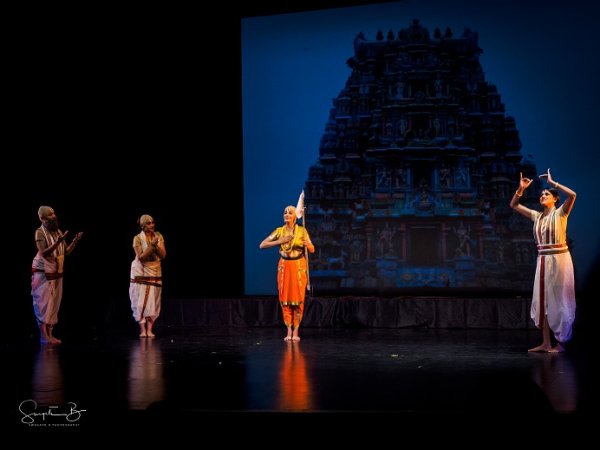
|   |

|   |
Sri Ramanuja Vaibhavam - Priya Das e-mail: priyafeatures@gmail.com Photos: Swagato Basumallick May 27, 2018 Sri Ramanuja Vaibhavam (Sri Ramanuja’s glory) was presented by Sri Chintanam in Cupertino, California, on May 4, 2018. Choreographed by Bharatanatyam guru Revathi Narasimhan, it revealed the extraordinariness in the life and philosophy of Ramanuja. The presentation met this goal: While one may have read an Amar Chitra Katha on Ramanuja in one’s youth, there were many episodes of his life not all in the audience were aware of. The staging of this narrative was the “dream” of Ranjani Rangan, who also emceed the show. The dance-drama had 20+ San Francisco Bay Area dancers cast into 71 characters who learnt their roles in a matter of 3 weeks: A major feat. Palo Alto-based dancer Kavita Thirumalai was instrumental in the casting and production detailing - it must have been a major undertaking. Care was taken to guide the audience along, with projected visuals that also enhanced some of the poses and stage effects. 

The Vaibhavam proceeded chronologically through 21 scenes over a two-hour presentation. This approach underscored the point that Ramanuja had the courage of his convictions from very early on; his convictions were far ahead of his times, and not born necessarily out of deliberate introspection. All he did was speak his mind, which happened to run contrarian to the social and philosophical underpinnings of society in those times. One came away thinking that the practice of Hinduism needed course correction then and perhaps even now – while Hindu philosophy as propounded by Ramanuja was inclusive, large masses of Hindus today still believe in several kinds of divisionism. The choice of Bharatanatyam as the channel to share his story had its advantages; communicating through mime compels the choreographer to only share the essence. It is to Narasimhan’s credit that she kept the depiction or natya on point, even though the Bharatanatyam rasika might be disappointed that there wasn’t much nritta. The visuals helped transport us to the location; however, it would have helped greatly if some of the key dialog was projected too, to help those not well-versed in Tamil. The (recorded) music composed by D. Srivathsa of Bangalore was evocative. There was evidence of Narasimhan’s attention to detail, such as the use of saashtanga pranam; the body language of orthodoxy; the expression of trickery even among supposedly pious Brahmins; above all, in the adherence to the artistic style of Bharatanatyam. From a narrative perspective, though, it must be said that an emphasis was laid more on the completeness of the story rather than keeping the storyline impactful. A few scenes added only minimally to the purpose of the recital. Examples include the birth of Ramanuja and his wedding (one could have started with the father educating the youth Ramanuja), when Ramanuja rejoins Yadavaprakasha (it is clear by then that Ramanuja had an immense thirst for knowledge). On the other hand, two scenes needed more care: Establishing that Thirukachi Nambi belonged to a lower caste (one realized this only when Ramanuja’s wife started cooking anew.) It was important to establish this since Ramanuja accepts his Pancha Samskaram from Nambi, rather than a revered Brahmin. The second scene was the one with the Dalit woman. The import of that episode was that the woman had no choice in the path she took because she was a Dalit. Perhaps it was here that Ramanuja realizes how truly curbed a Dalit’s freedom was? It would have been powerful to connect this episode to his inclusionary teachings.  The casting was done well; Aishwarya Venkat suited the role of young Ramanuja perfectly. The scenes/ dancers that stood out were the quarrel between wives Thanjamambal (Vinita Venkatesh) and Periya Nambi’s wife (Kaavya Venkataramanan); Egoistic Yadava Prakasha (Vibhushita Chandrashekaran), plotting and escape (Marshini Rao, Pallavi Bhatt); Forest dwellers (Sahana Kashyap and Swathi Sreenivasen); Chola princess (Sharanyaa Ganesan); Thirukachi Nambi (Deepa Srikanth); older Ramanuja and Tirukoshtiyur Nambi (Kavita Thirumalai and Ragashree Komandur). Other dancers were: Neha Anegondi, Anuradha Dwarakanath, Prahelika Rajagopalan, Revathi Raghavan, Adithi Anand, Aditi Kiran, Pooja Rao, Esha Dupuguntla, Anushree Thekkedath, Uma Maveli, Durga Sundar, Poorvi Kashyap, and Sharmila Gopinathan. In conclusion: Rangan alluded in her introduction that the need of the hour was to follow Ramanuja’s teachings to include rather than exclude; Narasimhan’s rendition of Sri Ramanuja Vaibhavam illustrated that. Priya Das is a writer based in San Francisco Bay Area, USA, covering extraordinary nuances of everyday life with a focus on the performing arts. She is a regular contributor to India Currents. Some of her writing is at www.priyafeatures.com |